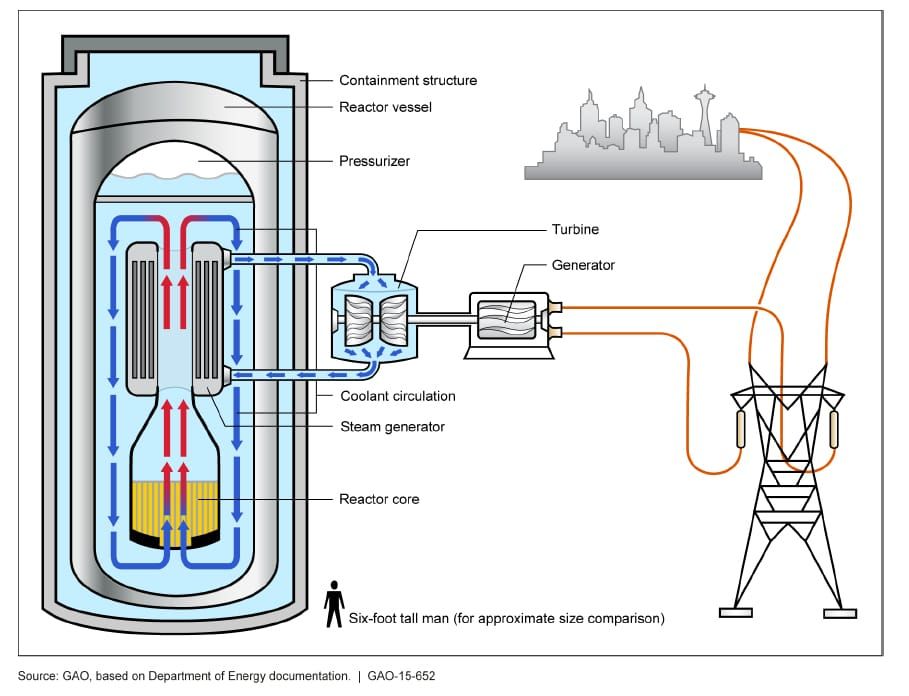Report: small nuclear reactors an ‘uncertain and unproven’ technology that could delay Australia’s transition to renewables
By Graham Readfearn | October 6, 2022
 Illustration of a light water small modular nuclear reactor (U.S. Government Accountability Office)
Illustration of a light water small modular nuclear reactor (U.S. Government Accountability Office)
Editor’s note: This story was originally published The Guardian. It appears here as part of the Climate Desk collaboration.
The next generation of small nuclear reactors being advocated by the Coalition would raise electricity prices, slow the uptake of renewables and introduce new risks from nuclear waste, according to a report from the Australian Conservation Foundation.
But the report from the conservation group has found only two small modular reactors (SMRs) are known to be operating around the world, in Russia and China, and both have seen large cost blowouts.
Promoters of nuclear energy, the report claims, were pinning their hopes on technology that was “uncertain and unproven”.
“The good news about the renewed nuclear discussion is that it highlights that business as usual with fossil fuels is not an option,” the report found.
“The bad news is the very real risk of delay, distraction and a failure to advance a just energy transition”.
Last week during question time, the energy minister, Chris Bowen, mocked the Coalition for supporting nuclear and asked which MP would be willing to have a reactor in their electorate.
Nuclear energy has been effectively banned in Australia since the late 1990s, but some Coalition senators are pushing for those restrictions to be lifted.
The opposition leader, Peter Dutton, has tasked the shadow climate minister, Ted O’Brien, to review the status of nuclear energy.
In the report Dave Sweeney, ACF’s Nuclear Free campaigner, wrote SMRs would push up electricity costs and introduce unnecessary challenges in managing nuclear waste.
“In short, Australia’s energy future is renewable, not radioactive,” he wrote.
According to the report, Russia’s floating nuclear plant, the Akademik Lomonosov, has two small SMR units on board. Construction costs had ballooned sixfold.
Work started in 2012 on a demonstration plant in China with two gas-cooled reactors that was completed nine years later, costing $8.8bn.
“The global SMR reality simply does not come close to matching the Australian SMR rhetoric,” the report says.
Three further SMR plants were under construction in Argentina, China and Russia but had been plagued by cost rises and delays, the report said.
In June, a study in the Proceedings of the National Academy of Sciences suggested future deployment of SMRs could increase the amount of nuclear waste by factors of two to 30, depending on the design.
In a report last year for the Minerals Council of Australia, the nuclear energy analyst and advocate Ben Heard argued there was a lack of standardised work on the true cost of SMRs.
But he said SMRs would hold a “substantial place in a lowest-cost decarbonised economy” and if they were available in Australia they would “widen the road to that decarbonised future”.
Heard argued SMRs could operate for more than 40 years delivering zero-carbon electricity.
He wrote: “Deploying nuclear power technologies requires a national uplift in competencies and capabilities that a country retains from that point forward.
“That journey might be accelerated, particularly for a nation with established capacity like Australia, but it cannot be rushed.”
In June the International Energy Agency said SMRs were not yet commercially viable, but “lower cost, smaller size and reduced project risks” could improve social acceptance.
There was increased support and interest in Canada, France, UK and the US for the technology, the report said, adding: “But the successful long-term deployment of SMRs hinges on strong support from policymakers starting now, not just to mobilise investment but also to streamline and harmonise regulatory frameworks.”

Together, we make the world safer.
The Bulletin elevates expert voices above the noise. But as an independent nonprofit organization, our operations depend on the support of readers like you. Help us continue to deliver quality journalism that holds leaders accountable. Your support of our work at any level is important. In return, we promise our coverage will be understandable, influential, vigilant, solution-oriented, and fair-minded. Together we can make a difference.
Keywords: Australia, energy transition, nuclear energy, small modular reactors
Topics: Climate Change, Nuclear Energy
















The article is like talking about a Ford Model T and saying modern cars are unsafe because Model T’s didn’t have seatbelts. Pointing out the problems of light water reactors is beating a dead horse. Everyone is painfully aware of them. Molten salt reactors solves most of the problems of LWRs and addresses the gaps in solar and wind power generation. The design has been around since the 1950s and a test reactor was built and successfully run at the Oak Ridge National Lab in the 1960s. Here is a link to a Government propaganda video about the program on… Read more »
There is, however, no prospect of building molten salt reactors with per kWh cost (LCOE) less than severalfold the already historically low and still dropping per-kWh costs of solar and wind. Even reactors using mature LWR technology are now far more expensive to build than solar and wind (https://www.lazard.com/perspective/levelized-cost-of-energy-levelized-cost-of-storage-and-levelized-cost-of-hydrogen/). As both renewables cost and storage cost (https://www.nrel.gov/docs/fy19osti/73222.pdf) continue to fall, the economic barriers to using nuclear reactors to address “the gaps in solar and wind power generation” become even more insurmountable. It is not even true that we need large dispatchable generators to compensate for those “gaps,” as utility professionals… Read more »